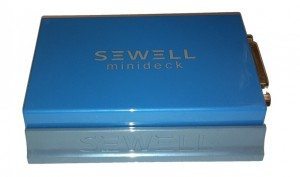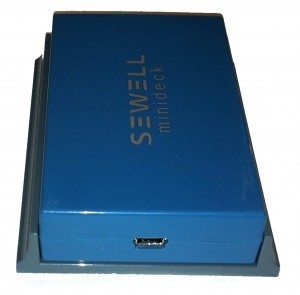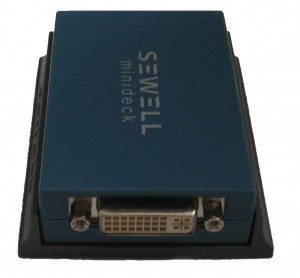 The Sewell MiniDeck is a small USB display adapter with drivers for OS X and Windows. You connect one end into USB and the other end into a monitor, and just like that you end up with another display without having to add a video card. The connected display won’t support 3D acceleration, but it does let you easily add an additional display to a laptop, desktop, or netbook. Read on to see how the device works, and how well it does driving a screen.
The Sewell MiniDeck is a small USB display adapter with drivers for OS X and Windows. You connect one end into USB and the other end into a monitor, and just like that you end up with another display without having to add a video card. The connected display won’t support 3D acceleration, but it does let you easily add an additional display to a laptop, desktop, or netbook. Read on to see how the device works, and how well it does driving a screen.
Out of the box, it’s a bit bigger than a deck of cards and easily travels in a laptop bag with the included carrying bag for the device, cables and adapters. There’s a USB port on one end and a DVI port that drives HDMI or VGA with small adapters. Configuration involves installing the Sewell MiniDeck drivers on the computer you’re going to use, then simply plugging it in. The CD included in the box is one of those Mini-CD’s that my drive doesn’t play well with, so I downloaded the latest drivers directly from Sewell’s website. I noticed the drivers were newer than what was printed on the CD, and because of this I recommend downloading the drivers instead of using the included CD.
Once the drivers are installed, you plug in a USB cable to one side of the SeWell MiniDeck and plug the monitor’s cable directly into the DVI port or the included adapter. The unit is powered over the same USB cable, so no power cables and the resulting cable clutter. Once the unit is plugged in, the monitor should start working immediately without any other action on your part. Audio isn’t supported on HDMI however, so you will need to supply audio using a separate cable while using HDMI.
Using the device with Windows 7 is pretty simple, provided you download the latest drivers and install them before plugging in the device. Once plugged in, the device activates and is controlled in Windows like any other additional display. You can mirror or span two ( or more ) screens, and there’s a taskbar app that allows you to select a special video mode for Sewell’s display. This video mode seems to blur the output a bit by making each pixel around twice as big, but does increase the video frame rate when playing large YouTube videos for example. You’ll definitely notice the larger pixels, but theres no questions is helps large videos play at a much faster frame rate. I had some issues with sleep in Windows 7, but removing and plugging the device into another USB port fixed this without a reboot.
The Mac OS X ( 10.6.8 ) experience is plug and play too after installing the drivers. Plugging in the MiniDeck activates the 2nd screen and the Display Preferences controls the settings, just like any other display connected to your Mac. There’s the standard fade out-fade in effect when you plug in the display and then your Sewell connected display is live. Display preferences allows you to arrange the placement of the display and tweak color settings the same way the internal video card works. Quality-wise, I couldn’t tell the difference between the internal video card on this MacBook and the MiniDecks’ output unless I had a full screen video playing, which I’ll talk about below.
USB Display adapters do have a few limitations regardless of the platform, like slowness when viewing video like YouTube and transitions with PowerPoint/Keynote content. Basically anything that involves 3D acceleration or huge amounts of moving pixels on the screen will run into the limitations. You’re also going to want to connect the adapter directly to a USB port on your computer, without going through a USB hub, to ensure a better experience. I had a couple issues when using the Sewell MiniDeck plugged into a generic USB 2.0 hub, and found the display much smoother when connected directly to a port on the computer. Basically, anything using 3D will be slow since there is no hardware acceleration. This most likely why transitions displayed at 720P fullscreen in Powerpoint stutter, but some transitions work better than others so you can get a decent presentation deck setup for viewing on a screen or projector connected to the Sewell MiniDeck if you experiment a bit with the different effects. The Sewell MiniDeck adds HDMI output, if you just want DVI output you can get the SW-8769 model priced at $79.95, but having the ability to plug this into any TV with an HDMI port is definitely worth it. I consciously set the resolution to 720p instead of 1080p because I’d rather a faster frame rate than higher resolution, and also because it’s easier for me to read small text at 720p on the TV I tried.

That’s an important tip: the fullscreen video slowness can be somewhat alleviated by setting your remote display to a lower resolution. 720P or even 1024×768 will allow for a much smoother presentation, or video playback for that matter, and to be honest the difference in picture from 1080P to even 720P was only clearly visible when sitting a few feet in front of the monitor. It was much less noticeable when being projected or on a TV from the distance an audience might sit. The bandwidth limit of USB 2.0 is most likely what we’re running into, 480mbit/sec isn’t that much when talking about video even if the signal is compressed. This is also another reason you don’t want to share that USB port with any other devices, reading from a flash drive connected to the same USB 2.0 hub would cause the display to slow down dramatically. Some laptops share USB ports too, where two external ports are connected to the same internal port, and I found it helpful to use a tool like SiSoft Sandra on Windows or System Profiler on a Mac to determine if the MiniDeck had exclusive access to a port.
There’s also the admirable ability to connect 6 monitors through USB ( 4 on Mac OS X however ), and along with the standard two ports on your computer that’s 8 displays! Although I’d most likely run out of unshared USB ports before I could plug in 6 MiniDecks on the computers I own, this could make a system surrounded by monitors possible for some interesting display setups. But the limitations, like the lack of 3d acceleration and slowness with higher resolutions, make this layout a bit impractical for everyday usage. With that said, it’s important to point out this is a way to add a digital output ( DVI/HDMI ) to an older laptop with only VGA output. Or add an additional display to newer computers that have limited display outputs like a netbook. It’s also great for servers connected to a KVM to add a display without unplugging everything, or headless units you only occasionally need to connect a display to, provided you install the drivers before plugging it in via remote desktop or a already connected KVM. VMWare machines can also use the MiniDeck, and the virtual Windows 7 machine I tried this with had full control over of the display connected to the MiniDeck – which creates another neat way to utilize the Sewell Minideck.
The MiniDeck is basically a low end video card in a box – You could add a screen to an older computer, connect to your TV via HDMI, keep it in a laptop bag as a fallback video card for a traveling presentation, use it on a headless machine, or even through a virtual machine. The Windows and Macintosh compatibility, USB power, and clean display quality make this an easy product to recommend as long you keep in mind you can’t play Call of Duty on the screen connected to it. The clean & crisp output and stable drivers make it even better, even with the limitations.
Anker Soundcore 2 Portable Bluetooth Speaker with Stereo Sound, Bluetooth 5, Bassup, IPX7 Waterproof, 24-Hour Playtime, Wireless Stereo Pairing, Speaker for Home, Outdoors, Travel
$44.99 (as of November 19, 2025 18:56 GMT -05:00 - More infoProduct prices and availability are accurate as of the date/time indicated and are subject to change. Any price and availability information displayed on [relevant Amazon Site(s), as applicable] at the time of purchase will apply to the purchase of this product.)Nanxudyj AUX Cord 6ft,3.5mm Stereo Audio Cable 90 Degree Nylon Braided 3.5mm Male to Male Stereo Aux Cables Right Angle TRS Cable Portable Compatible for Headphone, car,Tablets, Speakers
38% OffProduct Information
| Price: | $99.95 |
| Manufacturer: | Sewell |
| Requirements: |
|
| Pros: |
|
| Cons: |
|



Gadgeteer Comment Policy - Please read before commenting
I got something similar for half the price at dealextreme. http://is.gd/EeAwMa